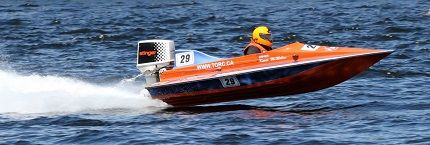hec2buck wrote:
:D If you consider using a 70 hp, 56 fishing motor or a SST-60, 56 block, and the port height variations from the stock motor to the SST-60, and then factor in the tolerances allowed on the ports, there is no way a pocket depth gauge will work. You may require a pocket depth of 0.530" on a stock 70 hp, or a pocket depth of 0.440" on a SST-60. If you consider the +/- 0.035" port height tolerance on the exhaust ports on any given motor, you end up with a potential of .070" difference from the low to the high of the spec. That's over 1/16". If your at the high end, or low end, the pocket depth of the head could change as much as 0.060"-0.080". That is just the variation on a given motor. Then you go to a SST-60, and the exhaust and intakes are closer to the deck, and still have a tolerance of +/- 0.035".
If the rule says 160 psi, that covers it all. Two racers with the same SST-60 motor, but different port heights within the spec., could see a variation of 5-15 psi on a compression gauge. If both racers wanted 160 psi, then the one with the higher box stock compression would probably do nothing, while the racer with the 15 psi lower compression would cut his head to achieve 160 psi. That would change the pocket depth of the cut head to 0.015"-0.020" less. Perhaps more.
Lastly, using a pocket depth gauge will require pulling heads, wasting costly gaskets etc.
If anyone has radical port heights that require a pocket depth of say 0.385" to achieve 160 psi, than I can promise you that individual will have no acceleration off the exit pins, and an extremely peaky power band, good only for top end.
Made this up, works great.
.565" long, .478" dia. Hard plastic with a 6-32 rod taped into it's edge. My head has a .525" pocket depth, 28.5cc, >10:1 C/R.
You can feel the piston touch but still easy to rock over TDC.
I propose this as next years test gauge, possibly reduce it .005"
Guys,
If you have raised ports, you will automatically have lower compression with this tool. That's the idea!
The whole point to this new way of checking the engines is to get away from a compression number all together. A mod engine usually has a higher set of ports, there for less compression "On a gauge!".(Every thing else being equal) This "Mod" engine will make more power IF allowed to have a "160"lb compression reading. This is where the "Mod" engine gets the advantage. Can you see that the piston stop will bypass that advantage. Look at ANY other form of racing and they do NOT use compression as a check, for good reason.
Another advantage is you do NOT have to disassemble anything, ever.
Way too many variables.
To name a few;
Compression reliefs
Cranking speed
Cranking duration
Starter condition
Ring gap
Ring seal
Oil in cylinder
Washed down cylinder
Engine temperature
Atmospheric pressure / temp
The gauge itself
The gauge hose volume
Leaks in plug fitting or shrader valve
Parallax
Carb opening
Butterfly reliefs
Reed stiffness / seal










